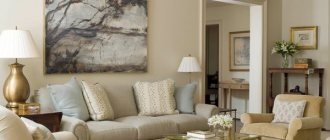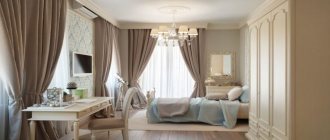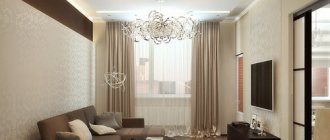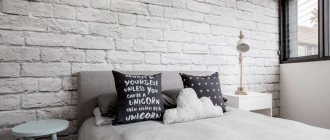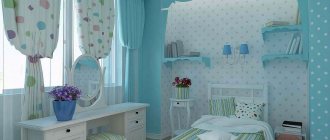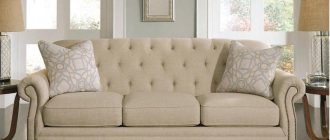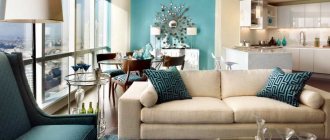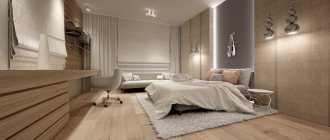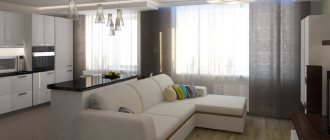Everyone knows that neutral colors go well with subtle and expressive colors. But sometimes the combination creates some difficulties. The combination of gray and beige in the interior, while attracting a lot of attention, raises no less questions. Is it possible to combine beige and gray shades and how beneficial they will look in the interior, read on.
Beige and gray: beneficial combinations for interior design
All of the neutral shades listed below are in close proximity to each other. These include:
- black;
- white;
- grey;
- brown;
- beige.
They are all compatible and easy to combine with each other. So, black, diluted with white, turns into gray, and light gray in combination with brown turns into gray-beige. Beige with black appears in a gray shade.
Psychology of gray
Psychologists consider gray a neutral color and note that people either love this shade or are simply loyal to it. Gray usually does not evoke strong negative emotions.
Gray does not distract from important matters, which is why it is the shade of suits for business people, offices of large companies and offices of top managers. According to psychologists, gray clothes give confidence to indecisive people.
At the same time, gray is credited with such qualities as reliability, friendliness and stability. These are precisely the characteristics that are often so lacking in the world around us. Despite all its practicality and modernity, gray is also considered mysterious and enigmatic. However, it is not surprising that so many meanings are attributed to it, because there are a huge number of gray shades.
How to play with halftones in the interior?
Since we are talking about a gray-beige interior, we will focus on this combination of colors.
Gray-beige tones are considered intermediate. In designer slang, it is referred to as “warm” or “French gray”; in English-speaking countries it is called “grey” (grey + beige). The named shade is characterized by calmness and monotony. Thanks to this, the gray-beige interior has a relaxing and calming effect on residents.
It is the more saturated, gray “grage” that is the best pair for combination with beige. As for the design, where gray is taken as the basis, from the “grange” shade palette it is better to take the one that is more saturated with beige pigment.
This tandem does not include sharp contrasts, and the result is a rather soft, warm, “powdered” interior.
“Grange” in a gray-beige interior can act as a transition color between the two main ones - beige and gray, which makes it possible to create the effect of a smooth transition from one shade to another.
The best ideas for combining beige with other colors in the interior
Beige and gray
Light shades expand the room, and the combination of two types of gray helps to adjust the dimensions and give the correct shape. Has a calming effect on the nervous system. For variety, you can add green or metallic elements.
Beige and brown
Doctors assure that the combination of beige and brown colors in the interior is most pleasing to the eye and relieves stress. It is important that there is enough light in such an interior. Do not overdo it with chocolate shades (no more than 40%). Can be diluted with burgundy or gold.
photo: Even massive dark furniture on a beige background does not seem bulky
Beige and blue
photo: In the design of the room, the proportions of beige and blue are perfectly maintained
Most often, beige acts as a background, and blue as an addition. These shades expand the space well and make it lighter. Combine cold and warm tones - then you can give the room the desired shape. An excess of blue evokes associations with cold.
Beige and turquoise
The combination of turquoise and beige is immediately associated with the sea coast; it is recommended to take white as a third color. Turquoise is used accentually. If you want to get creative, use dark brown or electric.
Beige and purple
The combination of beige and purple in the interior simultaneously calms and increases productivity. For bedrooms, choose soft lavender and lilac shades, for an office or living room - eggplant and violet. It is interesting to add splashes of lemon or yellow tint.
Beige and green
The combination of beige and green is the most natural color scheme, pleasing to the eye. You can use all shades: from herbal to emerald. The addition will be brown or white.
photo: Just a couple of bright elements – and what a result
Beige and pink
A gentle and sensual combination. Be careful with pink, otherwise the room will turn into the abode of a teenage girl. You can use more saturated purple and coral shades; white and light green colors will be an elegant addition.
Beige and white
When combining white and beige in the interior, it is important to correctly distinguish between these colors and not allow them to merge with each other. Use bright accents and textures. Metal accessories (copper, bronze, gold, silver) look great.
Fact: beige can “dissolve” in other pastel colors, so it is important to choose the right combinations and zone the space.
See a selection of photographs of interiors using beige and its combinations with other colors.
The good thing about beige color is that it is difficult to ruin a design with it. The only thing you risk is making the room too boring. This is the perfect shade for budding designers to inspire experimentation!
Options for combinations of the lightest shades in a gray-beige context
Another win-win combination would be light beige (ivory, cream, champagne) in addition to pale gray. Such tones are sometimes called vanishing tones because of their pallor, sometimes so strong that they are difficult to distinguish from white.
As a result of combining white tones in a gray-beige interior, a successful combination is always obtained. By decorating the interior in such a range, you don’t have to worry that it will look boring and dull. This is not at all true, especially if you support the color scheme with various textures, textures, and patterns.
If you doubt that the shade you have chosen will harmonize too well with beige, try diluting the design with one or more neutral colors: black, white, brown.
All representatives of this color cocktail belong to a related group. Don't neglect the rule of combination. Please note that two colors may clash slightly, while the third one smooths out this contrast, diluting the design and making the combination of gray and beige in the interior more pleasant.
Tips for creating a harmonious interior
Make active use of textures
If you want to make the interior calm and conducive to relaxation, then a clean combination of gray and beige will suit you. When you want to add stability and comfort to a room, add contrasting dark details. In any case, in order for the composition to be expressive, you need to use interesting textures. This can be structural wallpaper, brickwork or its imitation, long-pile carpets, carved elements, etc.
To make them look more advantageous, consider a lighting system. When light rays hit the texture at an angle, it looks more expressive and interesting. But this issue is best resolved with specialists who can advise on exactly how to install the lamps.
If you complement the gray-beige interior with bright colored elements, then the textures may already be less expressive. In this case, it is the color that makes the room interesting.
spectacular brick finishing and a huge clock in the living room, original decorative stone finishing in the kitchen and dining room, wall decor in the living room
Consider the position of the room
Gray is cool, and beige is warm. This is precisely their main difference. That is why it is necessary to take into account the location of the room when choosing the main color. If the windows face north, then let it be beige - it will make the atmosphere warmer. If there is always enough sunlight in the room, then it is better to take gray as a basis.
brickwork in a studio apartment, original wall design
Stick to stylistic consistency
To ensure that your home has not just a cozy, but also a stylish environment, try to maintain unity in each room. Although today it is rare that any design direction is used in its pure form, one must refrain from mixing bright and expressive details that clearly belong to different styles. Only experienced designers can make such bold decisions. If you don’t have any special knowledge, then learn the basics of your favorite style and try to stick to them.
brickwork instead of a standard apron in the kitchen kitchen-dining room in a minimalist style
As you can see, the combination of gray and beige in the interior can be expressive and interesting. To create the design of your dreams, think through all the steps of the upcoming renovation in advance, carefully select shades and textures. A careful approach is the key to ensuring that you feel cozy and comfortable in your home.
Gray beige in the guest room
In such a room, for finishing the floor, it is better to take a board of a dark shade if the walls are made in a light gray-beige color scheme, and a light one if, on the contrary, a dark gray-beige color scheme predominates on the walls.
Colors can be actively used for zoning. As a rule, in the living room there is a seating area near the sofa, a wall behind the TV and a desktop area, if one is present in the interior and is located against the wall.
Lighting is organized depending on need. If you have a large window and a light interior design, there is no need to use a large number of lighting fixtures. By playing with light, you can easily change the perception of the combination of gray and beige colors in the interior for the human eye.
Rules for using beige in the interior:
- The best solution is to choose beige as the background of the walls. For coloring, up to three shades of similar saturation are used.
- Uneven textures and play of light will help make beige more expressive. The beige shade loves multi-level lighting - then it becomes richer.
- To prevent 2 light beige shades from merging with each other, designers practice the technique of separating boundaries. Use moldings, decorative inserts, stencil designs.
- If you choose a beige color for the walls, you will visually make the room taller. The ceiling can be made in the same range, only in a different shade and, for example, in a matte variation - you will make the room visually proportional. A light ceiling combined with darker walls narrows the room.
- When choosing beige furniture, focus on texture. Choose the appropriate background. For example, smooth leather furniture harmonizes with textured walls, while fabric upholstery with a pattern will not blend in with a glossy background.
- If beige furniture is surrounded by dark or bright shades, you need to balance it somehow. Place your bet on textiles: light curtains or a rug will softly shade the set and complement it.
Please note: beige is used either for surface finishing or is present in furniture and textiles. A room with only one color will turn into a faceless, uncomfortable box.
photo: Using textured beige wallpaper you can highlight an accent wall
Gray-beige bedroom: is this a good choice?
The main focus in the interior in gray-beige tones is the use of rich chocolate curtains with a pronounced texture and other textiles in tone, filling the room with depth of color against the backdrop of pastel walls and floors.
A bed with an accentuated surface behind the headboard stands out effectively. It could be a gray square against the background of the beige walls of the room with an interesting pattern, almost white, for example, a dream catcher with decorated beads and feather pendants.
Combination of beige with other colors in the interior
What does beige go with?
Conventionally, color schemes with beige can be divided into three categories:
- Classic - this includes shades that are close to beige: light and dark brown, sandy, white, caramel and others. This interior is very elegant.
photo: A room in which only shades of beige are used does not seem dull at all
- Natural - beige is complemented only by shades that are often found in nature. This includes gray, blue, turquoise, green, pink. Promotes relaxation and relaxation.
photo: A room in natural colors is conducive to relaxation and does not irritate the eyes
- A game of contrasts. Bright and catchy tones are added to neutral beige - black, blue, purple, orange, red. An excellent solution for extravagant design.
photo: Rich blue gives depth to the room, and beige gives softness
Gray-beige bathroom
The mosaic finish in gray and beige tones looks interesting in the bathroom. Moreover, these may not be plain squares, but imitating pearl, mother-of-pearl inclusion surfaces. To match the style of such an interior, darker furniture is chosen, against which the white tabletop stands out in contrast. In the article you can see what a gray-beige interior looks like in the photo.
We hope that the description provided will help you decide on the choice of gray-beige color scheme for interior design, and the presented rules and recommendations will be useful when choosing materials.
Beige shades
Combining beige with various other colors will help create a composition in the room and make it cozy. If we talk about wall shades, they can be called completely differently:
- lactic,
- sand,
- Ivory,
- solar,
- coffee with milk,
- caramel,
- wheat,
- fawn, etc.
It is not necessary to use shades to decorate the walls. Beige curtains in the interior can also bring warmth and balance to the space. Experienced designers often act in this way to make window decor stylish and light, spectacular and comfortable. If you decide to use such window decor, you must take into account the purpose of the room. For the bedroom, it is better to purchase dense fabrics so that they effectively block the flow of natural light, creating comfortable conditions for sleep and relaxation.
Warm tones bring light and energy to a space. They are an excellent choice for the living room, nursery, bedroom and any other room. If it is located on the sunny side, it is better to place accents using cool colors to balance the space and refresh it.
Selection of materials and textures for a beige interior
An excellent companion for beige wallpaper is natural wood, imitation wood and various plant materials. Shades of beige include rattan, bamboo, veneer, cork, as well as less expensive materials, such as laminate. Wood treated with stain looks good.
An interesting design element will be a wall with light decorative plaster, cork and stone inserts. Ideal for interiors in light colors are leather furniture in coffee, cream, milky shades, as well as sand floors with an imitation of wood structure. The right approach to interior design will ensure comfort and visual pleasure from being in the room; it is only important to correctly combine colors and place accents!
